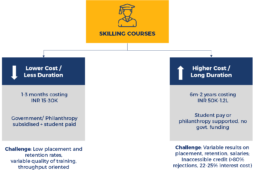India today faces an unprecedented skilling and unemployment crisis, with severe implications for economic growth and prosperity. The country faces a dual challenge of a severe shortage of skilled manpower in industries on the one hand and high youth unemployment on the other, highlighting a strong mismatch between the demand and supply for skills in the labour market.
OVERVIEW OF THE SKILLING LANDSCAPE IN INDIA
Strengths
India’s workforce can be its biggest strength as it aims to become the third-largest economy in the world.
India enters a 37-year period of demographic dividend. Such periods are often marked by rapid growth.
India adds 12 million people to its workforce every year! By 2027, India will have the world's largest workforce.
In 2016, India had the most number of graduates in the world at 78 million.
India tops the world in producing the most number of female STEM graduates. Overall, we are second in STEM only to China.
Challenges
Many new workers are not employable because their technical, social and behavioural skills are lacking.
By 2028, if skill-building does not catch up with the rate of technological progress, India could forgo USD 1.97 trillion of GDP.
Only 4.7% per cent of India's workforce has undergone formal skill training. In Germany and South Korea, the numbers are 75% and 96% respectively.
Roughly, 431 million of the workforce are in the informal sector. Not easy to upskill or reskill.
Around 75% of technical graduates and 90% of other graduates in India are considered unemployable.
Opportunities
India has immense potential and offers numerous opportunities in its existing skilling and schooling system.
Elaborate training infrastructure: Industrial Training Institutes, Polytechnics, vocational high schools, and Government training partners.
High aspirations amongst students and youth to upskill and access better opportunities.
India has many organisations that offer high-quality technical and 21st-century skills training.
High-quality skills training can result in better jobs, higher incomes and improved career progression.
We Want To Catalyse Livelihood Generation
Through Skilling With Differentiated Strategies

Lower Cost/Duration
Strategy: Outcomes Fund Structure with outcome-based top-ups to existing funding to improve placements
- Impact investors to provide top up funding to short duration mass skilling courses and get paid back by philanthropy
- Aim is to increase placement rates and retention at cohort level
- Delivers greater value-for-money on a per-outcome basis, even if that means potentially increasing the per-beneficiary costs
- Conversations with select reputable Training Partners ongoing to identify focus areas and design programs
High Cost/Duration
Strategy: Blended Debt Products with First Loss Default Guarantee to improve opportunities for low income youth
- Leverage philanthropic capital as first loss guarantee pool to provide for 4-6X number of students and establish evidence for market based structures with lower risk / FLDG coverage
- Program design to include an end-to-end focus on prioritising placements, income levels and earning potential
- Leverage NBFC Partners for operational platform, reporting, data analytics and technical assistance
